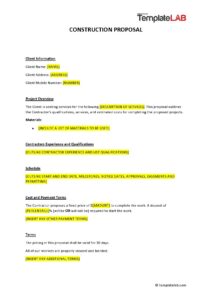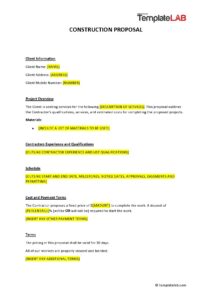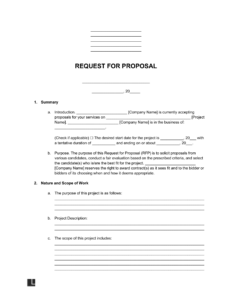Utilizing a structured approach streamlines the procurement process, promoting transparency and efficiency. A well-defined document helps contractors accurately estimate costs and develop competitive bids, ultimately saving time and resources for all parties involved. This process fosters a level playing field, encourages wider participation, and can lead to more favorable pricing and higher quality work.
The following sections delve into the key components of such documents, best practices for their creation, and strategies for evaluating responses effectively.
Key Components of a Construction Bid Request
Effective bid requests require specific information to ensure clarity and facilitate accurate bidding. The following components are essential for a comprehensive document:
1. Project Overview: A concise summary of the project’s purpose, scope, and location provides context for potential bidders.
2. Scope of Work: A detailed description of all work required, including materials, labor, and timelines. This should be as specific as possible to minimize ambiguity and ensure accurate cost estimations.
3. Drawings and Specifications: Technical drawings and specifications provide visual and technical details necessary for accurate bidding. These documents should be clear, concise, and readily accessible to all potential bidders.
4. Instructions to Bidders: Clear instructions on the bid submission process, including deadlines, required formats, and contact information, are crucial for a smooth procurement process.
5. Evaluation Criteria: Defining the criteria used to evaluate bids, such as price, experience, and proposed methodology, promotes transparency and fairness.
6. Contract Terms and Conditions: Including key contractual terms and conditions in the bid request ensures that bidders understand their obligations and protects the project owner’s interests.
7. Bid Form: A standardized bid form ensures consistent information from all bidders, simplifying the evaluation process. This form should include spaces for pricing, proposed timelines, and other relevant details.
Careful attention to these components facilitates a more efficient and effective bidding process, leading to informed decisions and successful project outcomes.
How to Create a Construction Bid Request
Developing a comprehensive bid request is crucial for successful project procurement. A well-structured document ensures clarity, promotes fair competition, and enables informed decision-making. The following steps outline the process for creating an effective construction bid request.
1. Define Project Scope: Begin by clearly defining the project’s objectives, deliverables, and overall scope. This includes specifying the project’s location, size, and key features.
2. Develop Detailed Specifications: Create comprehensive specifications outlining all materials, labor, and equipment required for the project. Include technical drawings, performance requirements, and quality standards.
3. Outline Instructions to Bidders: Provide clear instructions on the bid submission process, including deadlines, required formats, and contact information. Specify the required documentation, such as licenses, insurance certificates, and bonding information.
4. Establish Evaluation Criteria: Determine the criteria that will be used to evaluate bids, such as price, experience, proposed methodology, and safety record. Clearly communicate these criteria to potential bidders.
5. Develop a Bid Form: Create a standardized bid form to ensure consistency and facilitate comparison. The form should include spaces for pricing, proposed timelines, and other relevant details.
6. Review and Refine: Before issuing the bid request, thoroughly review and refine the document to ensure clarity, accuracy, and completeness. Seek input from relevant stakeholders to identify potential areas for improvement.
7. Distribute the Bid Request: Distribute the bid request to a qualified pool of potential bidders. Utilize appropriate channels, such as online platforms, industry publications, and direct outreach.
8. Manage Bid Submissions: Establish a clear process for receiving and managing bid submissions. Ensure confidentiality and maintain accurate records of all received bids.
A meticulously crafted bid request promotes transparency, encourages competitive bidding, and sets the stage for a successful project outcome. This structured approach facilitates efficient procurement and contributes to overall project success.
Effective project delivery relies heavily on a well-structured approach to procurement. Standardized documents soliciting bids ensure transparency, facilitate fair competition, and enable informed decision-making. Through detailed specifications, clear instructions, and established evaluation criteria, these documents provide a framework for successful project execution. From defining the project scope to managing bid submissions, a rigorous process promotes efficiency, reduces risks, and contributes to favorable project outcomes.
Careful consideration of these elements allows organizations to leverage the power of competitive bidding, ultimately driving cost savings, enhancing quality, and promoting successful project completion. Embracing this structured approach represents a commitment to best practices in construction procurement, leading to greater efficiency and value in project delivery.


